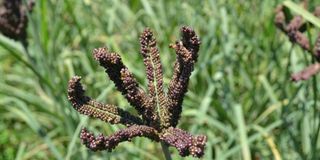How you can boost your farm with grains

What you need to know:
Unlike other grains, finger millet is richer in protein and rare minerals. It has high amounts of methionine, an amino acid lacking in the diets of people who live on starchy foods such as cassava, cooked bananas, polished rice, or maize meal.
Scientists at the National Agricultural Semi - Arid Resources Research Institute (NaSARRI) have been tasked to breed more improved dryland cereal crop varieties at the centre of excellence in East and Central Africa.
These are cereal crops capable of growing in semi-arid lands tolerant to prolonged dry spells namely finger millet, sorghum and pearl millet.
Background
The programme leader for Drylands Cereals Research at NaSARRI, Dr Scovia Adikini explaining the background of dryland cereal crop breeding notes that finger millet and sorghum breeding began at the Institute in 1960’s.
She highlighted finger millet as a historical crop whose indigenous origin is from Uganda with 2,000 land race varieties.
However over time scientists have development about 12 finger millet improved varieties 13 sorghum varieties and four potential varieties of perl millet which are still under field trial.
However due to climate change effects and demands for better varieties that can resist the changing climatic conditions, NaSARRI has been made centre of excellence to breed improved varieties for the region for the three crops.
Finger millet
Out of the 12 varieties so far released, the recent ones are Naromil1, 2, 3 and 5 which were released in 2017 with high yielding attributes, good for brewing, nutritious and containing fibre which is good for the body.
These varieties are capable of giving yields of three tonnes per hectare but the scientists will embark on breeding varieties which will yield more.
Benefits
The profound benefits of finger millet include ability to break starch to liquids. The germinated (malted) finger millet grain acts as a catalyst to liquefy any of the world’s major starchy foods: wheat, rice, maize, sorghum, potatoes, cassava, turning these staples into liquid form, pre-digests the starches and makes the food easy for the body to absorb. By releasing the food sugars, it renders even the blandest staples palatable. Finger millet is also a vital baby food due to its above element mainly for weaning purposes.
Adding a tiny amount of malted finger millet grain turns a bowl of hot starchy porridge into a watery liquid that matches the viscosity of a bottled baby food, such as those sold in supermarkets. This is fed as full meal to a child who is too small or too weak to get down solids.
Unlike other grains, finger millet is richer in protein and rare minerals. It has high amounts of methionine, an amino acid lacking in the diets of people who live on starchy foods such as cassava, cooked bananas, polished rice, or maize meal.
Its protein (elusinin) is more easily digested and it has the third highest iron content of any grain, after amaranth and quinoa, a South American ‘super grain’.
Finger millet is the only crop that can tame farmers’ after harvest losses because of its resistance to pests.
The seeds are so small that weevils cannot squeeze inside. In fact, its unthreshed heads resist storage pests so well they can be stored for 10 years or more without insect damage. It is said that if kept dry the seed may remain in good condition for up to 50 years. Finger millet boasts of having an African Origin.
It is said to have originated from the highlands of Uganda and Ethiopia and is grown in Sudan, Kenya, Tanzania, DRC, Malawi, and Zambia.
Hundreds of thousands of people in Ethiopia depend on finger millet as an important food crop. Currently the annual production is estimated at 30 million tonnes with Africa accounting for over half of it. It is important to note that whereas its production is decreasing in some African countries such as Kenya, in Asia (India, China, and Nepal) its production is steadily rising.
Challenges
There are challenges farmers growing finger millet encounter such as striga weed incidences, finger millet blast which dries the leaves and stem borer.
Farmers are currently advised to control using appropriate agronomy and soil management including crop rotation and application of manure.
Sorghum
According Adikini, so far there are 13 sorghum varieties with Seerdo varieties released in early 1960’s but the recent ones which were released in 2017 are Narosorg 1, 2, 3, and with good brewing attributes. The most common variety farmers are growing for food is Seso3 which was released in 2011.
However they have been breeding varieties and i have come up with six candidates with potential for both food and brewing which they intend to release soon.
The team is going to breed more varieties mainly to address the needs of brewing industries. The attributes include addressing the yield capacity to meet the demand of the breweries as well as for food security for the consuming communities.
The crop according to the scientists has become an industrial crop therefore the need to breed varieties to address the same need.
It has challenges of the stem borer that destroys the plant from the stalk thereby causing collapse.
Finger millet
Finger millet is the only crop that can tame farmers’ after harvest losses because of its resistance to pests.
The seeds are so small that weevils cannot squeeze inside. In fact, its unthreshed heads resist storage pests so well they can be stored for 10 years or more without insect damage. It is said that if kept dry the seed may remain in good condition for up to 50 years. Finger millet boasts of having an African Origin.




